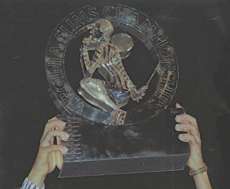Virginia Slims Circuit

The Virginia Slims Circuit
Background
The Open era began with the British Hard Court Championships in Bournemouth in 1968. At the first Open Wimbledon, the prize-fund difference was 2.5:1 in favour of men. Billie Jean King won £750 for taking the title, while Rod Laver took £2,000. The total purses of the competitions were £14,800 for men and £5,680 for women.[4] By the 1970s, the pay difference which had been a 2.5:1 ratio between men and women had increased. In 1969, ratios of 5:1 in terms of pay were common at smaller tournaments; by 1970, these figures increased to 8:1 and even 12:1.[5]
The situation came to a head in 1970, when most tournaments offered four times as much prize money to men than they did to women. At the 1970 Italian Open, men's singles champion Ilie Năstase was paid US$3,500 while women's singles champion King received just US$600.[6] On top of this, the USLTA failed to organise any tournaments for women in 1970.[7]
The campaign
This section needs additional citations for verification. (May 2009) |
King and eight other female tennis players – Americans
Gladys Heldman and the "Original 9" decided to target the
The formation
This section needs additional citations for verification. (May 2009) |
Heldman, with the assistance of Joe Cullman of
See also
References
- General
- Bodo, Peter. The Courts of Babylon. pp. 128–29. ([1])
- Collins, Bud. The Bud Collins History of Tennis. pp. 154–55.
- Specific
- ^ "Tour honoured by women's sports foundation". Sony Ericsson WTA Tour. 14 October 2008. Retrieved 10 May 2009.
- ^ "The "Original 9"". Women's Sports Foundation. 2012-06-19. Retrieved 2019-03-05.
- ^ "King, original 9 reunite to honor women's tennis". Retrieved April 7, 2012.
- ISBN 0-07-034625-9.
- ^ King & Starr, p. 120.
- ^ "'We've come a long way, baby' -- Honoring the 'Original 9' in 'Battle of the Sexes'". espnW. Retrieved 2019-03-05.
- ^ admin (2015-09-23). "Looking Back On The Original Nine". WTA Tennis. Retrieved 2019-03-05.
- ^ Nick Friend, for. "'Tennis gave me the ability to be somebody': Julie Heldman on depression and bottling up abuse". CNN. Retrieved 2019-03-05.
- Sony Ericsson WTA Tour. Archived from the originalon February 18, 2009. Retrieved 9 May 2009.
- ^ Vergara, Paula. "A league of their own: The historical grassroots of the WTA Tour". On the Baseline. Retrieved 10 May 2009.
- ^ "Billie Jean King | Virginia Slims Tour | American Masters | PBS". American Masters. 2013-08-04. Retrieved 2019-03-05.
- ^ Roberts, Selena (21 August 2005). "Tennis' other 'Battle of the Sexes', before King-Riggs". The New York Times. Retrieved 9 May 2009.
Further reading
- Woolum, Janet (1998), Outstanding Women Athletes, Greenwood Publishing Group, OCLC 593764497
